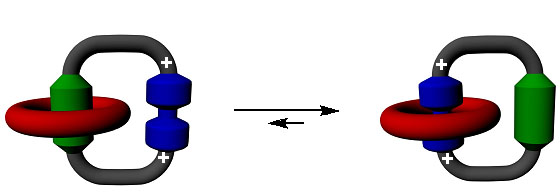Contact: Dan Krotz, (510) 486-4019, [email protected]
Berkeley Lab's Yi Liu is working to get the next generation of nanodevices to build themselves.
Imagine a car that assembles itself, each bolt and wire falling into place just so. Don’t expect this anytime soon, but scientists are making progress on a nanoscale version of this hands-free assembly line.
Using some of nature’s tricks, they’re coaxing molecular rings and rods to assemble themselves into machines that could be used in smaller, more powerful computers. Other potential applications include solar cells, energy storage, and catalysis.
“We’re identifying building blocks that can assemble themselves into useful nanostructures,” says Yi Liu, a staff scientist in the organic nanostructures facility at Berkeley Lab’s Molecular Foundry, a Department of Energy User Facility that provides support to nanoscience researchers around the world.
Liu is among a growing number of scientists at Berkeley Lab and elsewhere who are working to create the perfect chemical soup in which nanosized building blocks combine to form molecular machines — after only an initial nudge.
At the heart of this research is the need to develop easier ways to synthesize ever-more sophisticated nanodevices from readily available building blocks. In addition, current methods of improving some of today’s most useful items are beginning to plateau. For example, some scientists believe that the computer industry is approaching the limits of lithography, which is used to manufacture computer chips by etching circuits on a thin surface.
“That’s a top-down approach. Now people are talking about a bottom-up approach to computer memory that relies on the self assembly of molecules,” says Liu.
As inspiration, Liu refers to physicist Richard Feynman’s famous lecture, There’s Plenty of Room at the Bottom, in which Feynman advised scientists to consider the manipulation of individual atoms as the future of innovation in chemistry.

A simple molecular switch that builds itself. Berkeley Lab scientists first created the conditions for molecules such as catenanes to thread and clip themselves together, forming an interlocking structure. They then coaxed the structure to rotate when exposed to an electrochemical stimulus — the makings of a nanosized machine.
“But what is the key to the room? It’s chemical interactions,” says Liu.
With this in mind, Liu and colleagues are developing a convenient way to screen molecules for useful traits. They’re looking for molecules that aren’t stubborn when it comes to assembling themselves into more complex structures. Their approach is one part chemistry and one part mimicking nature, which boasts a vast toolkit for getting molecules to form functional machines.
“We test various molecular building blocks to see if they work together, and to determine if they’re easy to manipulate — almost like having a handle we can grab,” says Liu. “And if they do, we amplify the chemical conditions that bring the building blocks together.”
In this way, they’re creating molecular switches that turn on and off when exposed to electricity or light. The same goes for nanosized valves and nanowires. These molecules could form the basis of molecular memory for computers, in which information is stored in the location of movable rings of atoms. They could also be used in nanosized photovoltaic devices, which convert photons into electrical charges.

More complex structures are on the horizon, like this chain in which several catenane-derived molecules are stacked together. Variations of this assembly could be developed into a three-state molecular switch, which could lead to much faster, more powerful computers.
A recent success in Liu’s lab indicates that he’s on the right track. His team, which includes Liana Klivansky, a senior research associate at the Molecular Foundry, and UC Berkeley undergraduate students Gayane Koshkakaryan, Dennis Cao, and Angela Bruneau developed a reversible molecular switch based on catenanes, which are chain-like molecules. The parts that make up catenanes only weakly bond with each other, and are therefore difficult to work with, but Liu and colleagues created the optimum chemical conditions for them to come together. The result is a molecular switch that can be easily synthesized and controlled.
“We’ve developed a way to get catenanes to assemble very easily. The trick is orchestrating the different pieces to talk with each other in the way we want, and our recipe allows us to do this,” says Liu. “Ultimately, we need to learn how to arrange molecules to achieve certain functions — then we can say there is a lot of room at the bottom, and we know how to get into that room.”
Additional Information
- Learn about the Molecular Foundry.
- Read about Liu’s recent research with catenanes.
- Learn more about Liu’s research.